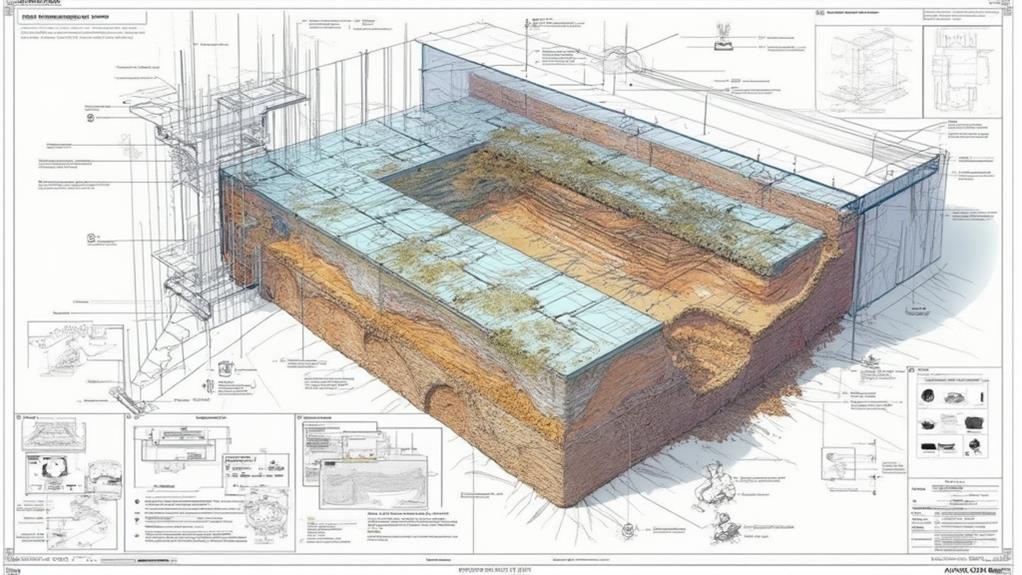Software is indispensable in retaining wall engineering, substantially enhancing design accuracy through sophisticated algorithms that account for diverse physical and environmental conditions. Its ability to facilitate detailed simulations fosters precise load analysis and guarantees optimal material usage, reducing waste and promoting sustainability. Additionally, software streamlines project management by compiling essential data, optimizing resource allocation, and improving team communication. It revolutionizes processes by automating calculations, therefore minimizing human error and expediting decision-making. By offering enhanced safety features through thorough risk assessments and real-time monitoring, software ensures that retaining wall projects are both safe and cost-effective, paving the way for further exploration.
Table of Contents
ToggleWalls Contractor Highlights
- Software enhances design accuracy by using advanced algorithms to account for physical attributes and environmental conditions.
- It performs efficient load analysis, accommodating numerous input variables and simulating environmental influences to prevent human error.
- Project management is streamlined with software, optimizing timelines, budgets, and resource allocation for efficient collaboration.
- Software optimizes material usage, reducing waste and promoting sustainable and cost-effective engineering solutions.
- Enhanced simulation capabilities with software allow for stress-testing scenarios, predicting potential failures, and ensuring structural integrity.
Role of Software Tools

In contemporary retaining wall engineering, software tools play an essential role by considerably enhancing design accuracy through advanced algorithms that account for numerous variables and constraints.
These tools are particularly valuable when designing complex structures like boulder retaining walls, which require specialized expertise and precise calculations. Additionally, they facilitate efficient load analysis by providing precise simulations that account for various forces and stress factors, thereby ensuring structural stability and safety.
These tools also streamline project management by integrating design processes with scheduling, resource allocation, and documentation, thereby promoting workflow efficiency and minimizing project timelines.
Enhanced Design Accuracy
Precision marks a critical advancement in retaining wall engineering, largely driven by the integration of sophisticated software tools. These tools enable engineers to achieve unparalleled design accuracy, fostering a stronger sense of confidence and community within the profession. By eliminating manual calculations and guesswork, software enhances design precision, reducing the likelihood of errors that could compromise structural integrity. Advanced algorithms process vast amounts of data, allowing for detailed simulations of wall behavior under various conditions. This capability guarantees that designs adhere to stringent engineering standards, ultimately contributing to safer and more reliable retaining wall structures.
The benefits of such precise design transcend technical results, fostering a collective identity among engineers dedicated to excellence. In today's digitally connected world, the ability to employ high-precision tools quickly becomes a benchmark of professional success and inclusion within the engineering community. With software facilitating thorough design documentation and reporting, parameter visualization and real-time modification are seamlessly incorporated into the workflow, promoting clear communication among team members and stakeholders. Consequently, enhanced design accuracy reinforces the shared mission of engineers to construct lasting and secure infrastructure, simultaneously elevating professional standards and supporting a culture of mutual respect and collaboration.
Efficient Load Analysis
Although engineering challenges can be complex, software tools greatly streamline the process of load analysis for retaining walls, making it more efficient and accurate. In addition, these sophisticated programs amalgamate multiple variables into comprehensive models, permitting civil engineers to predict the precise forces acting upon a retaining wall and assess its structural integrity under various conditions.
Software solutions are invaluable as they accommodate an array of inputs, including material properties, soil conditions, and external pressures, offering a holistic view of potential stress factors. Leveraging cutting-edge algorithms and calculation engines, these tools allow engineers to simulate environmental influences, such as groundwater movement and seismic activity, which are critical in ensuring the robustness of the design. Furthermore, the use of software minimizes human errors common in manual calculations, consequently enhancing the reliability of the results.
Key benefits of employing software tools for efficient load analysis include:
- Precision: Accurate computation of forces and moments acting on retaining walls.
- Flexibility: Ability to modify parameters swiftly, providing insights into various scenarios.
- Time Efficiency: Reduces the time spent on complex calculations, allowing more focus on innovative design.
This integration of technology into retaining wall engineering not only fosters a sense of belonging within the professional community but also instills confidence in achieving resilient structural solutions.
Streamlined Project Management
Beyond enhancing load analysis, software tools play a pivotal role in streamlining project management for retaining wall engineering. This integration facilitates a collaborative environment where communication flows freely among engineers, stakeholders, and clients, enhancing the sense of community and shared success.
Sophisticated software solutions enable detailed project tracking by compiling essential data such as timelines, budgets, and resource allocation in an accessible digital format. This precision guarantees that each member of the project team is informed and aligned with the overarching objectives, reducing the chance of misinterpretation and discrepancies.
Moreover, project management software tools offer advanced scheduling capabilities that allow for the anticipation of potential delays or disruptions. These systems support the optimization of workflows by dynamically adjusting schedules and resource allocation based on real-time data inputs, promoting a responsive and adaptable project ecosystem. This responsiveness is crucial in addressing unforeseen challenges, ensuring that projects remain on track and are delivered on time.
Ultimately, the integration of bespoke software for retaining wall engineering creates a cohesive project atmosphere, fostering an environment where everyone involved feels united towards achieving mutual goals, thus reinforcing their sense of belonging within the professional community.
Benefits

The integration of software tools in retaining wall engineering offers significant benefits, prominently including improved design accuracy, which guarantees the structural integrity and longevity of the walls. These tools are particularly valuable when designing boulder retaining walls, which require precise calculations due to their unique shapes and sizes.
Additionally, these tools streamline the analysis process, enabling engineers to execute time-efficient assessments that satisfy project requirements without compromising standards. Moreover, leveraging advanced safety features within the software enhances overall project security, while the cost-effective nature of these solutions aids in reducing expenses, making them appealing choices for projects with budget constraints.
Improved Design Accuracy
Precision in engineering is indispensable for the successful design and construction of retaining walls, and advanced software plays a critical role in achieving this accuracy. By utilizing sophisticated algorithms, engineering software enhances design accuracy and reliability, which are essential factors in ensuring structural integrity and client satisfaction. It allows engineers to meticulously account for various physical attributes and environmental conditions that might affect a retaining wall. This enhanced precision helps to minimize material waste and optimize the design for specific load-bearing requirements, promoting sustainability and cost-efficiency.
Advanced software solutions support the creation of detailed and accurate simulations, enabling engineers to anticipate and mitigate potential challenges before they manifest on-site. Furthermore, it fosters collaboration and consensus by synthesizing and rendering complex data in digestible formats that engineers can easily communicate and share with stakeholders. Embracing these technological tools cultivates a sense of community among engineers, property owners, and construction teams, who collectively work towards building resilient infrastructures.
- Accurate Load Calculations: Facilitates precise understanding of load dynamics.
- Optimized Material Usage: Reduces waste and promotes sustainability.
- Enhanced Simulation Capabilities: Enables robust stress-testing scenarios.
Through improved design accuracy, software fortifies the foundations of both retaining walls and collective ingenuity.
Time-Efficient Analysis Process
In the domain of engineering, a streamlined analysis process transforms the time-consuming task of evaluating retaining wall designs into a swift and efficient procedure. This shift is chiefly facilitated by sophisticated software, which greatly reduces manual hours spent on computations and design evaluations. Through automation and real-time simulation capabilities, complex scenarios can be evaluated with precision, allowing engineers to focus more on innovation and less on repetitive calculations.
The software utilizes advanced algorithms to optimize design variables, enhancing the capability to handle multiple iterations effortlessly. This not only accelerates the decision-making process but also integrates seamlessly with project management tools, fostering collaboration among team members. Engineers can thus engage in more dynamic dialogues and maintain alignment with project goals, contributing to a cohesive team environment and ensuring mutual commitment to project timelines.
Moreover, the ability to quickly generate extensive reports and visualizations assists in effectively communicating design concepts to stakeholders. This instant access to detailed assessments empowers teams to make informed decisions promptly. In an industry where time is often equated to cost, leveraging such tools not only optimizes resource allocation but also fosters a sense of inclusivity, ensuring that every participant is both informed and engaged.
Enhanced Safety Features
Leveraging sophisticated analysis software not only streamlines design processes but also markedly enhances safety features in retaining wall engineering. These advanced tools provide engineers with capabilities that transcend traditional methodologies, ensuring the stability and durability of structures amidst varied environmental conditions. By incorporating real-time data analysis and simulation models, software solutions enable engineers to predict potential failure modes and address them proactively. With the growing complexity of urban landscapes and infrastructure needs, these capabilities are invaluable in fostering safe and resilient developments.
Retaining wall engineering benefits greatly from software-driven safety enhancements, which facilitate:
- Thorough Risk Assessment: Software enables extensive evaluation of geological and hydrological data, helping to anticipate and mitigate risks before construction begins.
- Real-time Monitoring and Alerts: Continual monitoring through embedded sensors integrated with software systems can detect deviations from expected behavior, allowing for prompt corrective action to avert failures.
- Robust Design Validation: Analytical models within software assess load-bearing limits and structural integrity under varying conditions, ensuring compliance with safety standards and reducing the likelihood of structural failure.
Cost-Effective Solutions
Many innovative software solutions offer substantial cost-effective benefits in retaining wall engineering. By harnessing the power of advanced computation and automation, these software tools reduce project costs through optimized material usage and streamlined design processes. They utilize sophisticated algorithms to analyze various factors such as soil characteristics, load conditions, and environmental impact, thereby minimizing the risk of over-engineering and unnecessary expenditures. As a result, engineers can design structures that meet stringent safety and performance criteria without exceeding budgetary constraints.
Moreover, these software solutions enable collaborative project management, fostering enhanced communication among team members, clients, and stakeholders. This collaborative approach reduces the likelihood of costly errors and project delays. Additionally, the use of software tools can dramatically reduce the time required for repeated iterations of design testing and evaluation, further contributing to cost savings.
For organizations aiming to maintain a competitive edge, embracing these software-driven efficiencies is not merely an option but a necessity. The ability to deliver high-quality, budget-conscious projects fosters a reputation for excellence, which can lead to increased business opportunities and industry partnerships. Ultimately, by integrating software solutions, retaining wall engineering becomes a more efficient, cost-effective endeavor that aligns with industry and communal goals.
Soil Analysis Enhancement Tool

The Soil Analysis Enhancement Tool is pivotal in augmenting the precision of soil data, thereby enabling more accurate engineering assessments and reducing potential structural failures. Through automated stability calculations, this software minimizes human error and expedites the design process, ensuring that retaining walls are engineered with ideal safety standards. Additionally, its ability to visualize site conditions allows engineers to thoroughly understand the terrain specifics, fostering informed decision-making and streamlined project execution.
| Feature | Description | Benefit |
|---|---|---|
| Data Accuracy Improvement | Enhances precision in soil data collection | Reduces structural failure risk |
| Automated Calculations | Minimizes human error in stability assessments | Expedites the design process |
| Condition Visualization | Provides detailed terrain understanding | Informs decision-making processes |
| Integration Capability | Seamlessly connects with existing systems | Facilitates cohesive project workflows |
| User Interface | Intuitive design for ease of use | Increases efficiency in engineering tasks |
Improving Soil Data Accuracy
Enhancing the accuracy of soil data is pivotal for the successful engineering of retaining walls, as it directly influences the design's stability and safety. Precision in soil data diminishes uncertainties, leading to more secure structures and ideal resource utilization. Software in retaining wall engineering acts as an advanced Soil Analysis Enhancement Tool, meticulously refining the scrutiny of soil attributes such as cohesion, angle of internal friction, and load-bearing capacity. By employing sophisticated algorithms and artificial intelligence, engineers are able to interpret massive datasets with greater fidelity, thereby ensuring every granular detail about the soil conditions is captured effectively.
In this intricate process, several benefits arise:
- Reduced Risk of Overdesign: Accurate soil data helps in designing walls that are not excessively reinforced, consequently saving materials without compromising safety.
- Enhanced Site Specific Solutions: Customized solutions are developed by understanding the unique soil characteristics at each site, fostering innovation and accountability.
- Timely Identification of Potential Challenges: Precise data analytics enable the early detection of soil issues such as erosion or groundwater variability, prompting timely mitigation measures.
Such improvements in data accuracy empower engineers to forge a path towards creating retaining wall solutions that resonate with stability and reliable performance, fostering a sense of trust and belonging within the engineering community.
Automating Stability Calculations
In the domain of retaining wall engineering, automating stability calculations plays a pivotal role in advancing precision and efficiency. Through cutting-edge software applications, engineers can leverage sophisticated algorithms that transform complex geotechnical data into actionable insights. By automating the calculation of parameters such as sliding, overturning, and bearing capacities, these tools empower engineers to make data-driven decisions with increased confidence.
This streamlining of processes guarantees results that are not only consistent but reproducible, minimizing human error and accelerating project timelines.
For an industry where accuracy is paramount, the Soil Analysis Enhancement Tool exemplifies the integration of technology with engineering expertise. The tool meticulously processes soil characteristics, integrating various data sets to assess potential stressors on retaining wall structures. This enables engineers to develop designs that ideally balance safety and resource efficiency.
Additionally, these software tools provide user-friendly interfaces which encourage collaborative engagement among project stakeholders, fostering a shared understanding of critical factors that influence stability.
In embracing such advancements, retaining wall professionals not only enhance their technical proficiency but also strengthen their position within a community that values innovation and sustainability in engineering. As a result, the industry witnesses a harmonious confluence of tradition and technology, driving successful outcomes.
Visualizing Site Conditions
Harnessing the power of the Soil Analysis Enhancement Tool, engineers are provided with a sophisticated means to visualize site conditions accurately. This technological advancement is pivotal in crafting robust retaining wall designs that are both durable and efficient.
By integrating an array of soil data into one seamless visualization platform, engineers can assess a site's geological nuances, anticipate potential challenges, and make informed decisions preemptively. This capability to perceive subsurface conditions in a virtual environment before breaking ground empowers the creation of tailored engineering solutions that cater to the unique demands of each site.
The value of this tool extends well beyond just initial site assessments. It offers:
- Data-Driven Insights: Engineers leverage thorough soil analysis for informed decision-making, minimizing risks and maximizing safety.
- Enhanced Collaboration: By visualizing complex subsurface conditions, the tool fosters a collective understanding among project stakeholders, ensuring aligned project objectives.
- Predictive Modeling: It assists in forecasting potential soil behavior under various conditions, aiding in the formulation of proactive management strategies.
For professionals committed to excellence in retaining wall engineering, the Soil Analysis Enhancement Tool encapsulates a blend of technology and insight, ensuring each project resonates with safety, precision, and innovation.
Walls Contractor FAQ
How Do Software Tools Improve Communication Among Engineering Teams?
Software tools enhance communication among engineering teams by facilitating collaboration through centralized platforms. They enable real-time information sharing, reducing miscommunication, fostering a collaborative environment and ensuring all stakeholders are engaged and informed throughout a project's lifecycle.
Can Software Predict Long-Term Durability of Retaining Walls Under Varying Conditions?
Software can indeed predict the long-term durability of retaining walls by simulating diverse environmental conditions. It utilizes advanced algorithms and historical data, fostering a communal understanding among engineers to collaboratively enhance structural integrity and reliability over time.
What Training Is Needed to Effectively Use Engineering Software?
To effectively use engineering software, thorough training is essential. This includes understanding software functions, implementing best practices, and engaging in continuous learning. Joining professional communities enhances skills through shared knowledge and collaborative problem-solving, ensuring efficient software utilization.
Are Software Solutions Customizable for Specific Engineering Project Needs?
Software solutions are indeed customizable to meet specific engineering project needs, fostering a collaborative environment where engineers feel empowered and understood. Tailored features guarantee projects align with unique goals, enhancing both efficiency and cohesion within engineering teams.
How Does Software Integration Work With Existing Engineering Workflows?
Software integration seamlessly aligns with existing engineering workflows by enhancing communication, optimizing project management, and facilitating data sharing. This fosters a collaborative environment where team members contribute effectively, ensuring streamlined processes and successful project outcomes for the entire community.







